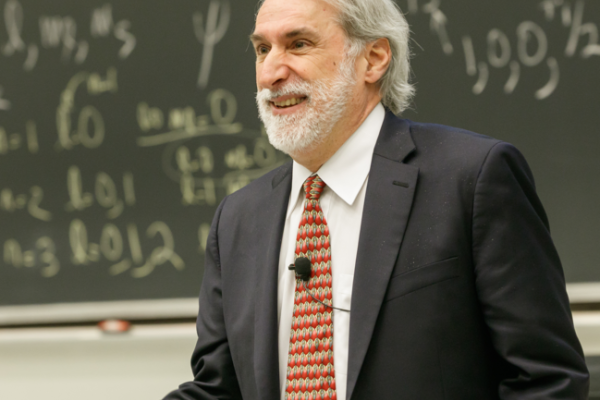Daniel Nocera of Harvard visits for 2016 Evans Lecture

A huge thanks to Professor Daniel Nocera of Harvard University who visited CBC last week for the 2016 William Lloyd Evans Lecture and Graduate Poster Session. Please click here to find photos from his visit.
Professor Daniel Nocera, Harvard
Professor Nocera is the Patterson Rockwood Professor of Energy at Harvard and he is widely recognized as one of the world’s leading researchers in renewable energy. His group has pioneered studies of the basic mechanisms of energy conversion in biology and chemistry. He accomplished a solar fuels process of photosynthesis–the splitting of water to hydrogen and oxygen using sunlight and translated this science to produce the artificial leaf, which was named by Time magazine as Innovation of the Year for 2011.
He has since elaborated this invention to create the bionic leaf, which performs artificial photosynthesis that is ten times more efficient than natural photosynthesis. Nocera has received numerous awards, including the Leigh Ann Conn Prize for Renewable Energy, Eni Prize, IAPS Award, Burghausen Prize, Elizabeth Wood Award, the United Nations Science and Technology Award, and a number of awards from the American Chemical Society. He is a member of the American Academy of Arts and Sciences, the U.S. National Academy of Sciences, and the Indian Academy of Sciences. He founded the energy company Sun Catalytix; its technology is now being commercialized by Lockheed Martin.
William Lloyd Evans Lecture Description:
The Evans Lecture at Ohio State University was established in 1961 upon the dedication of Evans Laboratory, in recognition of the late William Lloyd Evans for his distinguished service to the Department of Chemistry. Each year, a faculty committee has been charged with selecting a chemist of outstanding international stature to receive the Evans Award and present the Evans Lecture.
William Lloyd Evans (b. 1871) received the M.S. degree in 1896 from Ohio State and joined the Chemistry Department faculty in 1905 after having received his Ph.D. degree that year under Professor Ulric Nef at the University of Chicago. As an Assistant Professor in charge of the course in General Chemistry, “Billy” Evans was soon recognized as an especially effective and inspiring teacher. He rose to the rank of Full Professor in 1911, and his service to the Department was interrupted only by a two-year period of military service during World War I at Edgewood Arsenal. In 1928, he was named Chairman, succeeding Professor William McPherson.
During his tenure as Chairman, a post that he held until 1941, he steered the Department toward increased emphasis on graduate research. He encouraged the development of a strong research-oriented faculty and the expansion of research through involvement of outside industry and government agencies in sponsored programs. Following his retirement in 1941, Professor Evans was elected President of the American Chemical Society, and he continued his work in chemistry during active retirement until his death in 1954 at the age of 83.
The Dow Chemical Company has generously supported the Department of Chemistry and Biochemistry at The Ohio State University over the years for various important endeavors. Most recently, Dow has partnered with the Department to create new poster presentation awards during the annual Evans Lecture, the Dow Graduate Student Poster Competition and reception.
Prior to the poster session, each student has been asked to submit a written summary of their research. Each summary is assessed on the goals and accomplishments, the student's contribution to the work, and how the project impacts the field. The summary is used to select approximately ten posters to be judged during the poster session. In addition to these criteria, poster presenters will also be evaluated on organization and presentation style, knowledge of the field, and innovation.
The winners are selected by a total of six judges, three from Dow and three from Ohio State, and are based on both the written research summary as well as presentation of the poster. The Dow Graduate Student Poster Competition features three monetary award levels given to a total of five graduate students. Three awards were given to the best posters.
